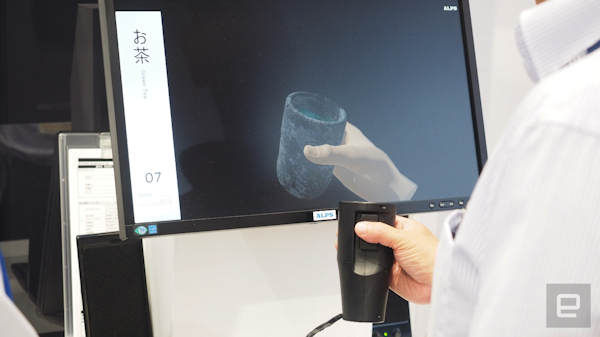[This is an interesting demonstration of presence and its potential; the story from Engadget includes a second picture, and more information about ALPS’ development and application of haptic technology is available from the company’s website. –Matthew]

How about a nice hot cup of virtual tea?
Haptics combined with heating and cooling elements deliver the feeling (if not the taste) of a cup of tea.
Mat Smith
10.05.16
Electronics company ALPS tests (and manufactures) all kinds of things. But its virtual cup, made possible by haptic technology and heat transmission, is the electronics manufacturer at its weird best. The cup, which is the size of a typical tumbler, is able to transmit a material’s tensile strength and even the temperature of your beverage of choosing. That is, as long as it’s cold water in a plastic cup or hot tea in a mug. As you tilt it, you feel the weight of the cup shift, and hear the water slosh around. As Engadget’s Deputy Tea Editor, I can confirm that the effect is… freaky.
The question is, why? Well, it’s linked to the electronics manufacturer’s efforts in virtual reality and telepresence: communicating touch digitally so that someone not actually present can get a similar (if not the same) experience. When the faux cup is filled with digital cold water, your fingers gently chill, with contacts on the sides of the cup delivering the temperature change. The reverse is true when the computer pours your faux tea. It was just hot enough to startle me. (On a personal note, the lack of virtual biscuits cookies was frustrating.)
The sensors also push back depending on the virtual material the cup is meant to be made of. With a plastic cup, it “squished” like it was meant to. Again: It’s weird.
Sure, no businesses are looking to deliver the experience of a digitally replicated cup of tea; it’s a demonstration of the kind of analogue sensations the company can deliver through technology. ALPS also had a haptic pad that was able to replicate tile and (for some reason) denim. Other surfaces, naturally, can also be programmed too. The technology delivers a similar tactile sensation with motors as your finger runs across it. The cup delivers a more uncanny experience — it’ll be exciting to see where the company takes it next.